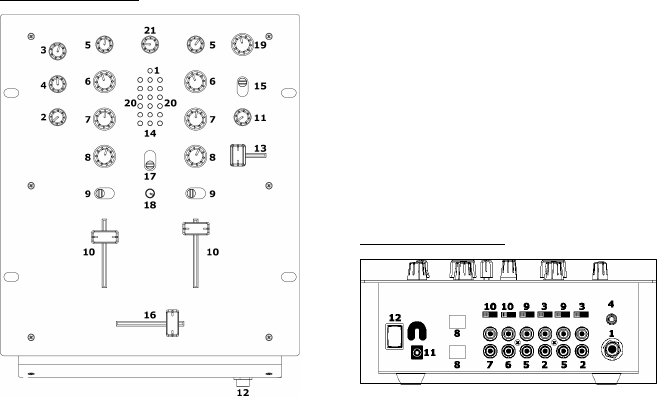
FRONT PANEL FEATURES
1. Power LED: Illuminates when the mixer is on.
2. Mic Gain: This knob adjusts the volume of the
microphone input.
3. Mic Treble: This knob adjusts the high-tone
of the microphone.
4. Mic Bass: This knob adjusts the low-tone of
the microphone.
5. Channel Gain: This rotary control adjusts
the pre-fader input level.
6. Channel Treble: This rotary control adjusts
the high-tone level.
7. Channel Middle: This rotary control adjusts
the middle-tone level.
8. Channel Bass: This rotary control adjusts the
low-tone level.
9. Input Selector: This toggles select what
input source is routed to the channel from the
rear panel connected units.
10. Channel Fader: This slide fader is used to
adjust the level sent to program mix.
11. Headphone Volume: This rotary control
adjusts the volume level of the headphone
output.
12. Headphone Jack: Your headphones can be
connected to this ¼” terminal. The volume
should always be set at its lowest setting while
connecting and disconnecting headphones to
prevent damage to headphones and/or your
hearing.
13. Cue Slider: Channels 1 and 2 can be
previewed using this mini-crossfader. Sliding
this to the left plays the left “channel-1” and
sliding to the right plays the right “channel-2”.
14. Cue Meter: This meter shows the peak,
“PFL”, Pre Fader levels of channels 1 and 2.
You can use the channel “Gain” and “EQ”
controls to match the levels of input signals
while cueing.
15. Master Cue Selector: When selected only the
master output is heard in the headphones.
16. Replaceable Crossfader: This slide fader
blends audio between the channels assigned
to the left and right assign switches.
Note: This fader is user replaceable if it
should ever wear out. Simply remove the
facepanel and then remove the screws holding
it in position. Replace the fader with a quality
authorized replacement from your local
Numark retailer.
17. Crossfader Direction: Activation of this
switch reverses the assignment of CH-1 and
CH-2 on the crossfader.
18. Crossfader Contour Control: The position
of this control determines how quickly or
intensely the crossfader will blend.
19. Master Output Knob: This rotary control
adjusts the main output volume.
20. Stereo Level Indicator: quickly and
accurately tracks level of audio.
21. Sub Bass: Reproduces sub-harmonic
frequencies one octave below and adds them
to the original signal. The result is increased
bass.
REAR PANEL FEATURES
Note: It is recommended that the mixer be
turned off before connecting and disconnecting
any sources to the inputs of the mixer.
1. Microphone Input: Microphones with a ¼”
connector can be connected to this input
terminal.
2. Phono Inputs: This input is used for connecting
your turntables through the sensitive RIAA phono
preamplifiers. Only turntables with phono level
output should be attached. Line level turntables
and other devices may be attached if the
Phono/Line rear panel switch is set to the line
position.
3. Phono/Line Source Switch: This switch
activates and deactivates the sensitive RIAA
phono preamplifiers. Only turntables with
phono level output should be assigned when
the switch is in the phono position. Some
turntables offer line level output. To use these
turntables and other line devices like CD players,
switch the input to Line.
4. GND: This screw connector should be used to
secure any turntables or other devices connected
to the mixer that need to be grounded.
5. Line Inputs: CD players, Tape Decks, Samplers
or other line level input devices should be
connected to these inputs.
6. Record Output: This RCA output is for
connecting a recording device such as a tape deck
or CD recorder. The level of the record output is
based upon pre-master levels.
7. Master Output (RCA): This output is for
connecting an external monitoring device such as
a PA system, powered monitors or a home stereo.
The level of the master stereo output signal is
controlled by the master fader.
8. USB Jack: This sends and receives audio data
from your computer. The USB 1 jack sends audio
to the mixer’s channel 1, while the USB 2 jack
sends audio to channel 2. See the separate
instructions for how to use your USB mixer with a
computer.
9. Line/USB Source Switches: These switches
select between input from the USB jack and the
Line input jack.
10. USB Output Select Switches: These switches
select what signal is output through each USB
jack. For the USB 1 jack, you can output either
the Record output signal, or a direct output of the
